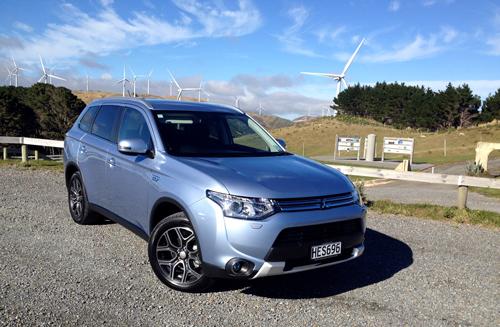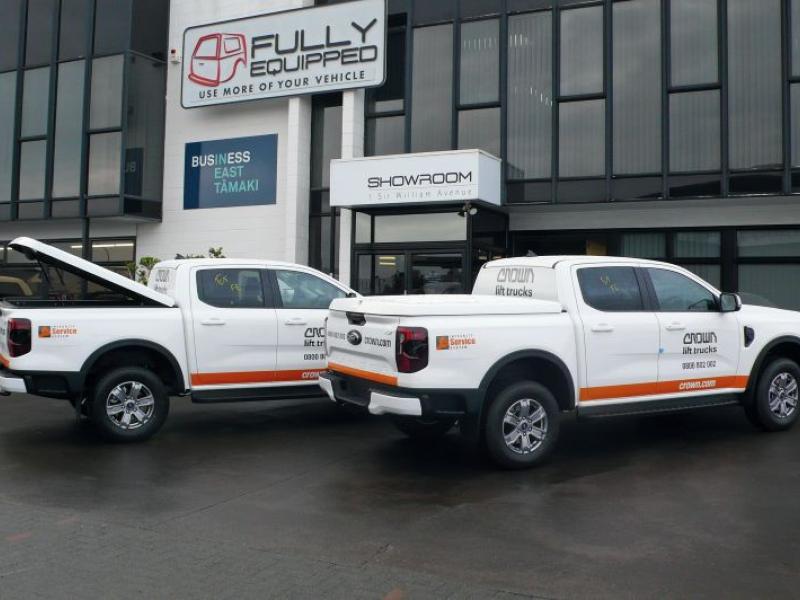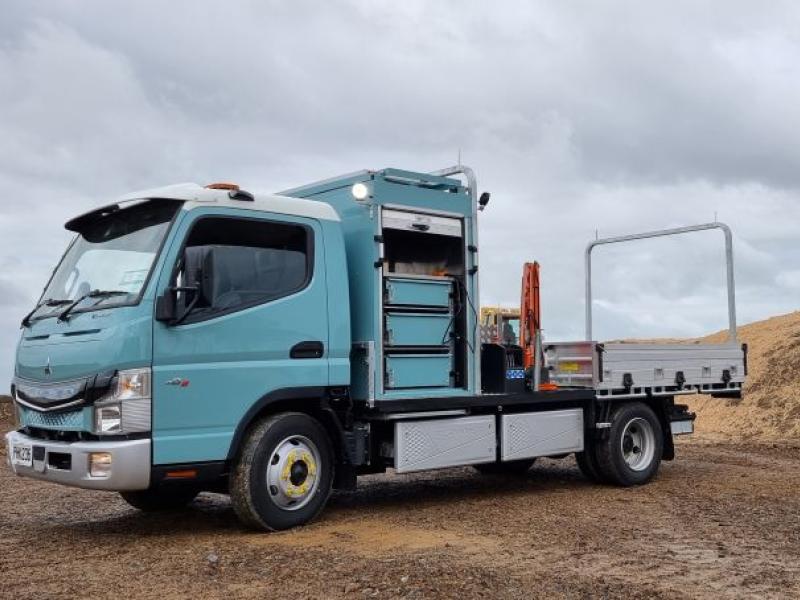One of the most exciting vehicles we’ve driven in a long time ships to dealers this month, the Mitsubishi Outlander PHEV. And forget the funny name, it’s just great, says John Oxley.
I’m not really into hybrids, or electric vehicles. Most of them are only compromises, and over the average life of the vehicle aren’t really going to save you much compared to, say, a good diesel, because of their high initial cost. And most of them are so darned ugly. Pure electrics are even more of a no-no – at least until the carmakers get the range problems sorted.
But Mitsubishi’s answer seems to solve most of my problems, plus a couple more I hadn’t thought of. For the PHEV is a vehicle you can plug into your ordinary household mains and give it enough of a shot to power you for a smidgin more than 50km without needing to recharge. That’s more than the average daily commute.
And then it’s got a petrol engine that pops electricity back into its battery so you can continue your journey without having to hunt around for a friend with a wall socket.
What’s more, its two-litre petrol engine can directly drive the front wheels, so you’re not getting any transmission losses.
Most important, you can launch your boat, or go off-roading with it, without having to worry about water getting into the electric motors or battery. Mitsubishi even entered one in an international off-road rally, and encountered no problems despite having to barge through lots of deep water.
And how’s about economy? On the launch of the vehicle held in and around Wellington, on a good mix of travelling that included city, hills, country roads, and motorway, one of our number (a journo, not an economy pro) managed to achieve Mitsubishi’s claim of 1.9L/100km. That meant the petrol motor had to kick-in a few times to provide extra grunt on the hills.
I drove it in my normal way, and got 2.8L/100km. I was happy with that.
That was on a journey of 52km. A longer trip would have used the petrol engine more often and that would have pushed consumption up. But only to around the 5 to 8L/100km level, which is still fantastic for a spacious five-seater SUV, and as good as or better than a lot of diesels on the market
What’s more, the PHEV looks just like a regular Outlander – which, by the way, has just gone through a facelift which makes it a lot more aggressive-looking at the front, and has taken away that blandness at the back that the outgoing model suffers from. It’s only a five-seater though, because of the battery pack, and the back seat squab is a bit higher than the normal Outlander’s.
Inside, of course, there are some changes to cater for the hybrid operation, with extra gauges that tell you the state of your battery pack, and whether it’s being charged by regenerative braking, or engine power, or in fact whether the petrol engine is running at all.
Can’t you hear it? Well, not really, it’s very quiet, and you certainly won’t know if you’ve got the radio on – or even have the aircon fan cranked up.
And now to the crunch question.
How much is it?
Well, to answer another way, the only two other plugins on the market, following the run-out of Mitsubishi’s own iMiev, are the Holden Volt and the Nissan Leaf.
The Holden, like the PHEV, has a petrol engine to recharge the battery if you run out of electric go, and its claimed range on battery alone is 87km. But it’s a not a very roomy car, and it costs $75,000 in a single specification.
The Leaf, on the other hand, is a pure plugin, with no further assistance if you run out of spark. Range is 120km on the European driving cycle, and it needs an electrician-installed 15A socket for recharging, so you can’t just plug it in at your mate’s house to top up the batteries to get home.
It’s a relatively small car, with not a lot of boot space, it’s got looks that even its mother might not like, and comes in a single specification at $69,700.
And then there’s the Toyota Prius. You can get big ones and small ones, but none has enough pure-electric range to boast about, nor are they plug-in. The small Prius C is quite pretty, but the normal five-seat Prius is ugly, with not a lot of boot room, and the seven-seater is even uglier. And all carry premium pricing.
So what about the PHEV?
It comes in two trim levels, mirroring those of the regular petrol or diesel Outlander – XLS, which is pretty well specced at $59,990, and the top-end VRX, which comes with all the bells and whistles, including satnav, leather trim, power tailgate, reversing camera, and radar safety/cruise technology, at $66,990. That’s $10,000 more than the diesel versions.
How do you get going?
Essentially, you just get in, push the start button (it’s got a proximity key), wait for the “Ready” light to come on, then select either reverse or drive, and off you go. Quietly.
It’s fast off the mark, there are no warm-up problems, and there are no gears to select.
You can do fancy things to try and save battery power if you want, but the best thing, really, is to leave the electronics to sort all that out. They’ll probably do a better job than you can, anyway.
One tip you CAN use is to put the gearlever into B, and it increases the regenerative braking, good for slowing the vehicle (like normal engine braking) when you’re descending a long hill, or towing. You can select how much retardation you want using the steering wheel paddles.
Officially the PHEV is only rated at 750kg for towing, but that’s to ensure there are no problems when it comes to extra-long hills, or towing in adverse conditions. But the chassis will handle 2,000kg.
So how does it all work?
First up, charging is dead easy. You just plug the supplied lead and controller into a socket, and it sucks power out of the grid at 8A. And you can get an app for your mobile phone which will allow you to select when it starts and stops charging so you ensure you’re only using off-peak power, and it takes 6 and a half hours to charge to 100 percent.
By the way, the app also allows you to do all sorts of other wonderful things from the comfort of your bed, such as remotely switching on the heater so the vehicle is nice and warm when you get in on a cold morning – or the aircon to cool the vehicle down on a hot day. You can also monitor the charge rate, and see how much battery power you’ve got.
The PHEV operates in three modes. EV mode is just that – electric only, and in that mode it’s always in 4WD. You can travel at up to 120 km/h in electric-only mode.
Series Hybrid is when the battery level is low, or during quick acceleration or hill climbing; the petrol engine kicks-in when necessary to top up the battery (it might only be for a few seconds), but the vehicle continues to drive using the electric motors only, still in 4WD.
Parallel Hybrid. This is at higher speeds – over 70km/h. If there’s not enough charge to run in EV, the two-litre petrol engine (it’s a detuned version of the one in the petrol Outlander, and peaks at only 4,750rpm so wear rates are low) will drive the front wheels direct, without any gearing, and assisted by the electric motors according to demand. There’s no gearbox.
If you’re going off-road, or need extra traction, there’s a 4WD button that allocates torque between the two axles, much the same as a locking centre diff. on a regular 4WD.
What else do you need to know in this short launch introduction to the PHEV?
This is no low-volume halo car, like the Volt and the Leaf; Mitsubishi is aiming for 20 percent of its Outlander volume to be PHEVs by 2020, provided the factory can meet demand. The lithium ion batteries are rated to last as long as 10 years at 80 percent capacity, the PHEV has 12 months/16,000km service intervals, and it’s got a 5-year/100,000km warranty.
We’re aiming to have a full road report in our June issue.






